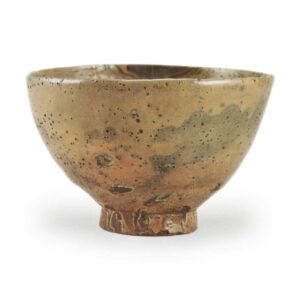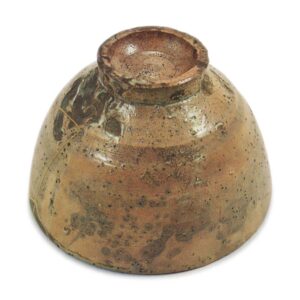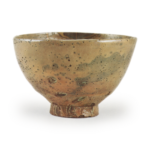

Height: 10.7-10.8cm
Diameter: 15.5-26.5cm
Foot diameter: 6.6cm
Height: 1.5cm
It is said that it was passed down in the former Daitokuji temple, and that is why it is said to have that name, but there are various theories about the name Daitokuji Goki. One of the most plausible theories is that the name “Goki (or Goki)” refers to tableware that was imported by ship, and that it was used by the emissaries from Korea when they stayed at Daitokuji as their lodgings. Another theory is that the name “Goki (or Goki)” refers to lacquered wooden bowls , and because a certain type of Goryeo tea bowl resembled this type, it came to be called “Goki”, and by chance, a Goki tea bowl came to be handed down to Daitoku-ji”, so there is also the idea that this is how it came to be called Daitoku-ji Goki. The facts of the previous theory are unknown, and the latter theory seems more plausible.
In addition to this tea bowl, there are also a number of other tea bowls of a similar shape that are also referred to as Daitokuji Goki. However, this tea bowl is the most difficult to make, and it is also the most famous because it is said to have been owned by Lord Matsudaira Fumai.
It was made on a potter’s wheel in a casual manner, and is large and slightly distorted. Its shape is simple and plain, yet the framework is strong and the content is full and rich. In particular, the stable foot, the sharp cutting, the large and natural spread from the foot to the rise, and the depth and breadth of the interior are wonderful.
The clay is somewhat rough, but also tenacious, and the glaze, which can be seen through the glaze, ranges from a light yellowish-gray to a reddish-peach color, giving the piece a generally bright appearance. The glaze is a transparent feldspar glaze that covers the entire surface of the vessel, and because it is a rough splash glaze and has been roughly handled, there are severe fingerprints and smudges, and the black dirt from use has also added to this, resulting in a significant amount of so-called “kake-hazushi” (glaze coming off in places). In addition, there are places where the glaze has been partially removed, but this is due to the different glaze layers adhering to each other in the kiln during the glazing process.
What is even more noticeable is the mottled pattern of light-grey spots that cover the entire surface. These are the result of small holes that have appeared in the glaze on the inside and outside of the cup, and are caused by tea stains that have seeped in over the years of use. These small holes are caused by an incompatibility between the components of the clay and glaze and the kiln fire, and in the case of this teacup, it appears that this is particularly severe because the glaze did not melt completely. The stains appear in various sizes and shades through the dull luster of the glaze, and the stains and the varying tones of the clay overlap, creating an unusual gradation of light and dark over the entire surface. In particular, the combination of the reddish-purple base and the light gray-blue speckles creates a mysterious purple stain that is strangely beautiful. Although these stains and flaws are not an intrinsic aesthetic element of the tea bowl, they have a unique charm that strongly appeals to people in the world of tea.
It was originally owned by the Daitoku-ji temple, then passed into the possession of Kyogoku Kumeemon of Kyoto, and in the Kansei era (1789-1801) it was sold to the lord Matsudaira Fumai for 500 ryou. Since then it has been passed down through the Matsudaira family, but in recent times it has changed hands several times and is now thought to be in the Tokyo area.
The bag for the addition is made of purple silk, the inner box is made of paulownia wood with a black lacquer finish, and the red lacquer writing on the lid is by Daitokuji Daito Gishin, and it says “Daitokuji jade tea tray”.
The middle box is made of paulownia wood, and the writing on the lid is by Matsudaira Fumai, and it says “Daitokuji Goki”.








